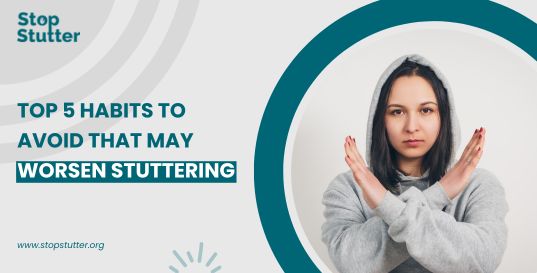Top 5 Habits to Avoid That May Worsen Stuttering

Standing in the Versailles of your mind, your heart pounding, yet the words awkwardly fail to get out of your mouth. Somewhere in the mind, someone would say, "Okay, this is what I want to say," and then it just isn't coming clearly. For many people who stammer, that can happen so often that, because of their embarrassment and frustration, they have a desire to push through to have an experience of talking without stammering.
Stuttering causes in anyone at any age, and can obliterate a person's self-worth, destroy social interactions, and affect the rhythm of daily living needs. There are many means that people use to "come to terms with their stuttering", mostly through some kind of therapy. But some harmful speech habits could be the "bad guy" making worse case scenarios worse for even a highly educated therapist's client. So recognizing and eliminating habits like these can be considered vital to a person's fluency.
In this blog, we go into depth concerning these five common behaviors witnessed in those who stutter and share some practical stuttering management tips on how to control stuttering while building more confident ways of communication on the side!
1. Rushing through your speech
The habit: Trying to "get it over with" by speaking too fast results in more disfluency.
How it makes stuttering worse: The more rapidly you speak, the more tension and pressure build, leading to more experiences of disruption, blocks, and repetitions.
What can you do instead:
- Keep Pace. Intentionally speak slower. Give yourself natural pauses to think about what you are going to say next.
- Breathing. Use some slow, deep breaths to keep your speech at a calm pace.
- Mindful speech. Focus on each word and give yourself the time to say what you believe you want to say.
Using these speech fluency tips will help you relieve the pressure to rush, so you may experience a more controlled flow of what you want to say.
2. Eye Contact Avoidance
The Behavior: Looking away or avoiding eye contact when communicating with others.
Why Would it be More Likely to Increase Stuttering? Avoiding eye contact can communicate that a person is uncomfortable and self-conscious. This may increase anxiety and the communication process.
What to do instead:
- Gradual Exposure: Start with maintaining eye contact in low-confidence conversations, and gradually go to higher-confidence conversations.
- Positive Reinforcement: Track and acknowledge small wins of maintaining eye contact to enhance confidence.
- Seek Professional Help: It may be beneficial to work with a Speech-Language Pathologist to identify strategies to support their eye contact to feel comfortable during speech.
Enhancing non-verbal communication presents an enhancement for overall fluency and can limit stuttering triggers.
3. Filler Word Overuse
The Behavior: Using filler words like "um," "uh," or "like" excessively to cover up disfluencies.
How It Amplifies Stuttering: Those words become a crutch and will develop over-use habits that worsen stuttering and prevent good speech strategies from being developed, while further disfluencing.
What To Do Instead:
- Strategic Pausing: Recognize that naturally occurring pauses exist in speech, and you can afford them. They don't need to be filled with filler words
- Silent Practice: When you have a pause, take a second for it to become silent; this will help develop your brain to stop mixing filler words when it can have silence.
- Speech Therapy: Use an online stuttering therapy to develop some techniques to counteract your behaviour, and it can directly address your reasons for using filler words.
Exposure to filler words can be minimized. It allows you to have clearer and intentional speech, improving fluency.
4. Avoidance of Difficult Words or Situations
Habituation: The intentional avoidance of specific words, phrases, or speaking situations due to worries about stuttering.
Why does it make stuttering worse? Avoidance only reinforces the fear and anxiety that accompany speaking. We fail to take the opportunity to practice speaking situations and develop our fluency.
What to do instead:
- Gradual Exposure: Step by step, face the words and speaking situation that causes the most fear in a controlled and supportive environment.
- Desensitization Techniques: You can utilize desensitization techniques, which you would develop with a therapist, to decrease the sensitivity to certain points through repeated familiarization in a non-threatening way.
- Positive Self-Talk: Develop a way of thinking that contemplates challenging speech situations as opportunities, not challenges.
When you avoid stuttering behaviors, it can help to realize your potential and be a more effective communicator.
5. Negative Self-Talk and Internal Criticism
The Habit: Engaging in self-critical thoughts and negative internal conversations about one’s speech.
Why It Makes Stuttering Worse: Negative self-perception can cause increased stress and anxiety, which leads to increased stated severity of stuttering.
What to Do Instead:
Cognitive Restructuring: Challenge those negative thoughts and replace them with positive affirmations of your ability to communicate.
- Mindfulness Practices: Practice some elements of mindfulness in order to aid you in being “in the moment” and minimizing anxiety directed toward a past or future speaking engagement.
- Support Networks: Engage with a support group or join online communities to share your experiences and derive inspiration from others.
- Establishing a practice of positive self-talk is crucial to managing stuttering and developing resilience.
Finding Help and Professional Assistance
Self-awareness and habit change are incredibly important, but nothing can take the place of professional assistance in making a change happen in your life. Online stuttering therapy includes all the programs available on online platforms. They make stuttering interventions and programming more accessible and allow for more personalized and individualized interventions because they allow people to get therapy with speech-language pathologists without leaving the comfort of their home.
Online therapy can provide interventions that a person can practice with real-time adjustment, with the continuous availability of other members to support habit change and reduce speech disfluency behaviors related to stuttering.
Let's Think About One Real-Life Example
There exists a person named Alex. Alex is a university student who has stuttered throughout his entry into the academic world. By working with Alex on identifying and changing his negative self-talk behaviors along with avoidance behavior of speaking in public and by engaging with Alex in an online stuttering therapy program, Alex practiced habit change and with the support of expert advice, Alex developed useful strategies for communication and was able to relate effectively with other members of the class, ultimately feeling confident enough to share the realities of being a person who stutters with his class! This change in his social congruity with his classmates is something that people who stutter want to accomplish. Alex demonstrated that with careful self-awareness as well as professional assistance, the habit can change.
Final Take
Stuttering causes a complicated speech disorder with many factors that may be either destructive behavior or a constructive habit that leads to progress. By noticing, controlling, and changing bad habits such as rushing, avoiding eye contact, excessive use of mixed fillers, avoiding challenges, and negative self-talk, you can help create change and improve fluency.
As a reminder, access to professional help through online stuttering therapy can give you the tools and support for effective change. You can overcome some of the challenges of stuttering if you are patient, persistent, and practice!
Note: IndiBlogHub features both user-submitted and editorial content. We do not verify third-party contributions. Read our Disclaimer and Privacy Policyfor details.







